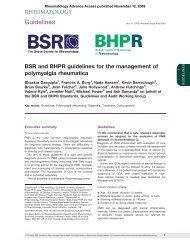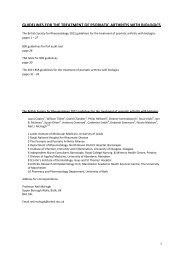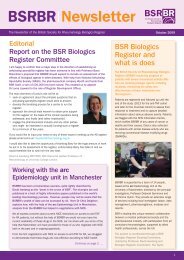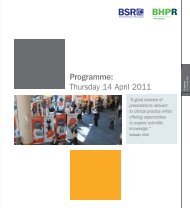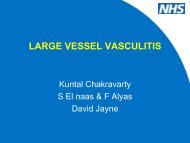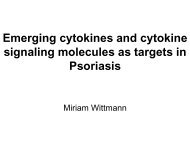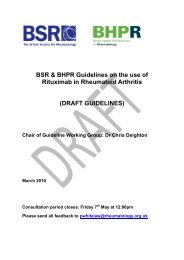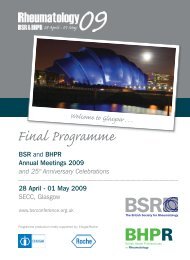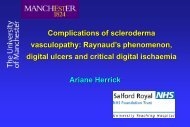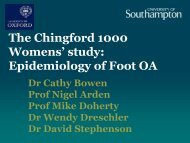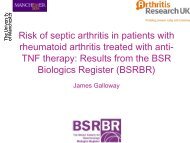22 April 2005 Final Programme - The British Society for Rheumatology
22 April 2005 Final Programme - The British Society for Rheumatology
22 April 2005 Final Programme - The British Society for Rheumatology
You also want an ePaper? Increase the reach of your titles
YUMPU automatically turns print PDFs into web optimized ePapers that Google loves.
14:30 – 16:30 Regenerative medicine and gene therapy Hall 4<br />
Chair: Yuti Chernajovsky<br />
• Genetic defects in co-stimulation - lessons <strong>for</strong> new therapeutic targets in<br />
rheumatology Prof. H-H Peter, Freiburg, Germany<br />
Based on mouse models and human immunodeficiences costimulatory molecules<br />
of the B7-CD28 superfamily (e.g. CTLA-Ig, ICOS) and homeostasis regulating<br />
molecules of the TNF-TNFR superfamilies (BAFF, BAFF-R, TACI) are becoming<br />
increasingly interesting new therapeutic targets <strong>for</strong> systemic autoimmune disases.<br />
• Tissue engineering: chances and challenges <strong>for</strong> application in rheumatic<br />
diseases Dr. Michael Sittinger, Berlin, Germany<br />
Autologous chondrocyte transplantation is routinely applied to treat traumatic<br />
cartilage lesions. However, regenerative therapies <strong>for</strong> chronic joint diseases are<br />
still in an experimental phase. Next generation tissue-engineering therapies<br />
will depend on "smart" delivery concepts based on the regenerative potential<br />
of progenitor cells and tissue <strong>for</strong>ming growth factors<br />
• Targeting cytokines to sites of inflammation Dr. Sandrine Vessillier, London, UK<br />
Latent cytokines have been engineered to increase their half life and target their<br />
activation to disease sites. Promising results have been obtained by DNA injection<br />
in a collagen induced arthritis model.<br />
• Inflammatory signalling and their cross talk during tissue development and<br />
regeneration Dr. Gerhard Gross, Braunschweig, Germany<br />
<strong>The</strong> downregulation of the inflammatory mediator protein, the MAP3-Kinase TAK1,<br />
significantly enhances TGF-beta/BMP and HLH-transcription factor dependent tissue<br />
regeneration. Signalling mediators leading to tendon/ligament <strong>for</strong>mation in vitro<br />
may be used <strong>for</strong> a regenerative therapy of tendons in vivo<br />
• Development of regulated vectors <strong>for</strong> gene therapy application<br />
Dr. David J. Gould, London, UK<br />
Development of gene therapy vectors that permit pharmacological and/or disease<br />
regulated transgene expression. How these vectors can be delivered in the<br />
treatment of disease, and progress that has been made in experimental arthritis<br />
models.<br />
14:30 – 16:30 Current concepts in osteoporosis – a combined session with the Bone and<br />
Tooth <strong>Society</strong> Hall 1<br />
Chairs: Jon Tobias and Richard Eastell<br />
• High bone mass phenotypes and osteoporosis Prof. Matthew Warman,<br />
Cleveland, USA An overview of the role of the cell surface receptor "low density<br />
lipoprotein receptor related protein 5" (LRP5) and the Wnt signalling pathway in<br />
human disorders of high and low bone mass.<br />
• <strong>The</strong> role of the RANK/RANKL pathway Prof. Steven Goldring, Boston. USA<br />
<strong>The</strong> talk will review the role of the RANK/RANKL pathway in the pathogenesis of<br />
bone loss associated with inflammatory arthritis. Potential approaches <strong>for</strong><br />
targeting this pathway to prevent articular and systemic bone loss in patients with<br />
rheumatoid arthritis and related <strong>for</strong>ms of inflammatory joint disease will be<br />
discussed."<br />
• Role of anabolic therapy in the treatment of osteoporosis Prof. Robert Lindsay,<br />
New York, USA<br />
Most agents available <strong>for</strong> osteoporosis treatment are antiresorptive in their action.<br />
That is they reduce remodling rate and stabilize bone density with a subsequent<br />
reduction in fracture rate. So called anabolic agents (such as teriparatide)<br />
stimulate both bone <strong>for</strong>mation and remodeling. <strong>The</strong> consequence is increased<br />
trabecular size and number as well as increased cortical thickness. <strong>The</strong>se agents<br />
repair at least some of the structural damage that we call osteoporosis. <strong>The</strong>y also<br />
6





